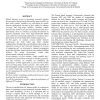Free Online Productivity Tools
i2Speak
i2Symbol
i2OCR
iTex2Img
iWeb2Print
iWeb2Shot
i2Type
iPdf2Split
iPdf2Merge
i2Bopomofo
i2Arabic
i2Style
i2Image
i2PDF
iLatex2Rtf
Sci2ools
IWDC
2001
Springer
2001
Springer
Satellite Systems Performance with TCP-IP Applications
Mobile Internet access is becoming extremely popular because users depend on the Internet for many activities in their daily routine. Satellites are well suited for mobile Internet applications because of their ability to enhance coverage and long-range mobility. Satellites remain attractive for mobile users (for both pedestrians and, more importantly, those in vehicles) accessing the Internet in sparsely populated areas where high bandwidth UMTS cells cannot be economically deployed or in regions where deployment of terrestrial facilities remains impractical. In this paper, we analyze various mobile Internet applications for both GEO and LEO satellite configurations (Iridium-like and Globalstar-like) using an enhanced version of ‘ns2’ (Network Simulator 2). As part of enhancing ns2, we developed a channel propagation model that includes shadowing from surrounding building skylines. The model incorporates actual data measurements collected in urban areas. In our analysis, we first...
Related Content
| Added | 30 Jul 2010 |
| Updated | 30 Jul 2010 |
| Type | Conference |
| Year | 2001 |
| Where | IWDC |
| Authors | Pierpaolo Loreti, Michele Luglio, Rohit Kapoor, J. Stepanek, Mario Gerla, Francesco Vatalaro, Maria Angeles Vázquez-Castro |
Comments (0)

